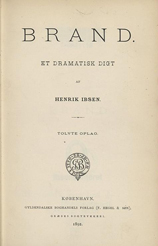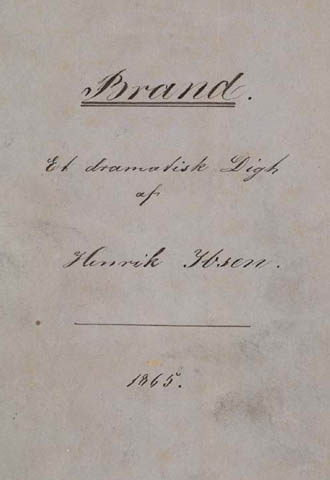

Brief description
In many ways the creative process leading to Brand started with an important political event: the war between Denmark and Germany over Slesvig-Holstein and the defeat of the Danish army at Dybbøl in 1864. Ibsen raged against Norway and Sweden for not helping the Danes. His rage and sorrow were not lessened when he was in Berlin on his way to Italy and «saw the howling mob wallowing in the trophies from Dybbøl, riding on the gun-carriages and spitting on the cannon» (letter to Bjørnstjerne Bjørnson dated 28 January 1865). It was during those days, Ibsen wrote some years later in a letter to Peter Hansen, «that 'Brand' began to grow like an embryo within me».
The first version of Brand was in the form of an epic poem. The chief character was not called Brand, but Koll. Ibsen worked on this poem until the summer of 1865, but was not satisfied, and so put the subject aside. It would not let him go, however, and it turned into a drama. The political satire was toned down in favour of motives drawn from the religious sphere. Koll became the clergyman Brand. In a letter sent to Bjørnstjerne Bjørnson from Ariccia on 12 September 1865, Ibsen describes how the subject finally came to fruition:
I went into St. Peter’s one day – I had an errand in Rome – and there I suddenly had a strong and clear realization of the right form for what I had to say. – Now I have thrown overboard everything that has plagued me for a year without letting me make any progress, and in the middle of July I started on something that developed faster than anything ever has before. It is new in the sense that it was then I started to write, but the subject and the atmosphere have weighed on me like a nightmare ever since the many terrible events at home made me look into myself and our life there, and think about things that earlier had just passed me by without taking them seriously, at any rate. It is a dramatic poem with a contemporary subject, serious content, 5 acts in rhyming verse (not exactly «Love’s Comedy»). The fourth act will soon be finished, and I feel that I shall be able to write the fifth in eight days; I am working both morning and afternoon, which I have never been able to do before. It is blissfully peaceful out here, with no acquaintances and I am reading nothing but the Bible, – it is powerful and mighty!
[read the letter in HISe]
The play was written in less than three months. The last act was completed in the middle of October 1865. Ibsen sent the rest of the fair copy to his new publisher, Frederik Hegel in Copenhagen, in the middle of November.
Brand came out on March 16th 1866 in Copenhagen. It was the first of Ibsen’s plays to be published by Frederik Hegel of Gyldendalske. The first edition consisted of 1275 copies. Hegel doubted the sales potential of the book, but his doubts proved to be totally unfounded. By the end of the year the book had been re-printed no fewer than three times, and its publication was like a bombshell in the intellectual life of Denmark and Norway. Brand was Ibsen’s breakthrough, and henceforth he was to be recognized as one of the greatest writers in Scandinavia.
Like Ibsen’s next play, Peer Gynt, Brand was not written for the stage, but as a closet drama. Nevertheless, the fourth act of the play was performed as a part of Laura Gundersen’s «Evening Entertainment» at the Student Union Theatre in Christiania on 14 May 1867, just one year after the publication of the book. Laura Gundersen herself played the part of Agnes, while Brand was played by her husband, Sigvard Gundersen. On 26 June 1867 the same production was included in the repertoire of the Christiania Theatre.
Nineteen years would pass, however, before the play was staged in its entirety. This was on 24 March 1885 at the Nya Teatern in Stockholm. Ludvig Josephson directed the production. The premiere performance lasted for six and a half hours. The demanding lead role was played by Emil Hillberg, Sweden’s foremost male actor. The staging was well received by both audience and critics, and performed on a further 15 occasions before the end of the year. In the Stockholm newspaper Tiden, Hjalmar Branting wrote: «The result was a complete triumph for the Nya teatern’s energetic director and for its outstanding actors».
The first complete production in Norway had its first night on 21 October 1895 at the Eldorado Theatre, but again with a Swedish company, the Swedish theatre director August Lindberg’s Company. Lindberg both directed and played the part of Brand himself.
(From ibsen.net)
Plot summary
Brand is a young clergyman with a strong sense of vocation. He thinks that Christianity has been watered down and Christians have become slack and too willing to make compromises. He demands that faith and life must be one, and that human life must be ruled by willpower.
At the beginning of the play he is making his way across the mountains, and he meets his old schoolfriend Einar and the latter's fiancée Agnes. They are a very happy couple, but Brand condemns their attitude to life. Next he meets the mad gypsy girl Gerd, who imagines she is being pursued by a hawk. She tries to get Brand to go with her to an «ice church» in the mountains, but he goes down to the valley and his old home there. He finds there is famine in the district, which he believes is God's punishment for the people's lack of faith. He sails out on the fjord in a storm to hear the confession of a dying man, and Agnes is so moved by his courage and faith that she joins Brand in the boat, bidding Einar farewell. Agnes and Brand marry and have a son, Alf.
Brand serves the parish as clergyman, and when his elderly mother lies dying he refuses her holy communion unless she gives away all her possessions, and she dies without being absolved.
The little boy Alf is ill, and the doctor says they must move to a better climate to save his life and health. Brand interprets this warning as a temptation to give up his vocation, and gets Agnes to agree that they must stay. Alf dies, and so does Agnes, after being pressed by Brand to sacrifice all her treasured «relics» of their son.
Brand has gradually acquired a strong position among the country people, and he gets them to build a large new church. But on the day that the church is to be consecrated he realizes that this is not where the people are to seek their God, and he takes them all up into the mountains to find God up there instead. The parishioners lose courage, turn against Brand and return to the valley. Alone, Brand continues to wander through the mountains in search of God. He is tempted by the figure of Agnes to give up his demand for «all or nothing», but resists the temptation. He then meets Gerd again, who believes she is Christ himself. Gerd fires a rifle shot in the direction of the hawk she believes is pursuing her, and the shot sets off an avalanche, which buries the two of them.
(Source: Merete Morken Andersen, Ibsenhåndboken, Gyldendal Norsk Forlag, 1995.)
Read Brand (in Norwegian)
In the online version of the official Ibsen edition (HISe) you can read Brand in various formats. This content is currently only available in Norwegian. Follow the links below to read the play:
Introduction to Brand (in Norwegian)
The online version of the official Ibsen edition (HISe) offers extensive information about Brand in Norwegian. Follow the links below to read about various aspects connected to the play.
- Background
- Creative process
- About the publication
- Stagings in Ibsen's life time
- Overview of editions and manuscripts
About Brand's precursor, [Episk Brand]
The unfinished work [Episk Brand] was initially written as a poem in the period of 1864/65. Ibsen discarded the work, however, and re-wrote it in dramatic form. He subsequently published it as Brand (1866).
Read [Episk Brand] (in Norwegian)
In the online version of the official Ibsen edition (HISe) you can read [Episk Brand] in various formats. This content is currently only available in Norwegian. Follow the links below to read the play:
Introduction to [Episk Brand] (in Norwegian)
Reviews
Here you can find reviews in full text and an overview of registered reviews in various languages.
- Reviews from Ibsen's life time in full text
- Reviews registered in the Ibsen bibliography (nb.no)
- Reviews registered in "Norsk litteraturkritikk" (UiO)
Translations
- The Multilingual Ibsen
- Translations in various languages
- Overview of translations from Ibsen's lifetime (HISe)